Widgetized Section
Go to Admin » Appearance » Widgets » and move Gabfire Widget: Social into that MastheadOverlay zone
Reviewing The Smith & Wesson’s New M&P 2.0
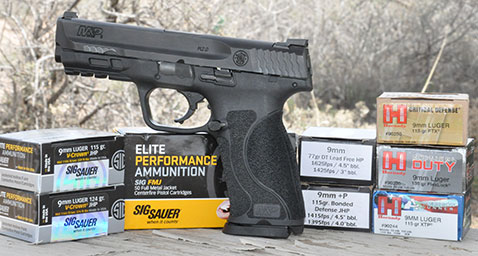 Time flies when you’re having fun. It seems like only yesterday when we introduced Smith & Wesson’s new M&P pistol during a weeklong media event at Gunsite. In the following eleven years or so S&W has sold roughly a gazillion M&Ps in variations too numerous to count. The pistols are available in 9mm, .40 S&W and .45 ACP with and without thumb safeties, in black or flat dark earth colors and with three dot sights or night sights. There are full size and compact M&Ps, not to mention the sub-compact Shield models in all their various calibers and configurations. There’s even a M&P in .22 caliber. It’s probably a safe bet to say the M&P series has been Smith & Wesson’s most successful product during the past decade.
Time flies when you’re having fun. It seems like only yesterday when we introduced Smith & Wesson’s new M&P pistol during a weeklong media event at Gunsite. In the following eleven years or so S&W has sold roughly a gazillion M&Ps in variations too numerous to count. The pistols are available in 9mm, .40 S&W and .45 ACP with and without thumb safeties, in black or flat dark earth colors and with three dot sights or night sights. There are full size and compact M&Ps, not to mention the sub-compact Shield models in all their various calibers and configurations. There’s even a M&P in .22 caliber. It’s probably a safe bet to say the M&P series has been Smith & Wesson’s most successful product during the past decade.
While Smith & Wesson was busily building out and marketing the M&P lineup the aftermarket crowd got into the act to address perceived weaknesses in the pistol. For example, some folks thought they weren’t accurate and needed a better barrel. Not in my experience – I guess I don’t shoot well enough to know there’s a problem – but it’s fine with me if folks want to enjoy tricking out their pistols. Another gripe has been present since the beginning and that has to do with the trigger, specifically the trigger reset. Comparing the M&P to the Glock is unavoidable and the Glock clearly has a crisper, audible reset. Several companies have produced triggers, parts and kits to address this, most notably Apex Tactical who already have a 2.0 trigger upgrade on the market.
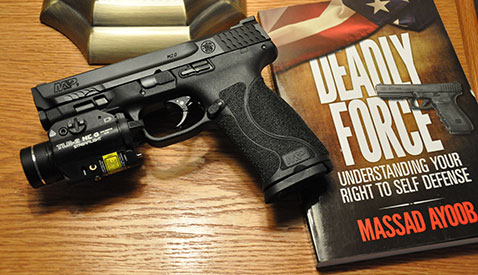
The fact is, there’s nothing wrong with the original M&P and we recommend them to new shooters taking classes at Gunsite all the time. Still, I imagine the folks at S&W saw an opportunity to broaden the M&P lineup and sell another gazillion pistols with the introduction of the M&P 2.0. What’s new and different? There’s a whole list of things starting with a trigger that has a positive feeling and audible reset. After a bunch of slack there’s a small amount of takeup and the trigger “snaps” cleanly. The trigger on my sample 2.0 in 9mm breaks at an average of 6 pounds and 3 ounces according to my Lyman electronic trigger tester gizmo. The new pistol has slide stops on both sides and the magazine release can be reversed. Empty magazines fly out of the pistol when the magazine release is pushed and I can reach it easily without having to shift the pistol in my hand. The grip portion of the frame has a new texture S&W refers to as an aggressive texture. I would describe it as a sharkskin texture that’s very positive without being abrasive. The 2.0 is available in 5 inch and 4.25” models and come equipped with steel three dot or night sights. My sample has the dots; it’s a 4.25” model and has no thumb safeties. In case you’re wondering there is no magazine disconnect. Two magazines are provided, both holding 17 rounds and prior magazines in the correct calibers will work just fine in the new pistol as will holsters designed for the previous models. One other addition, should you be prone to chamber checking your pistol by grasping the front of the slide S&W has thoughtfully added a small set of scalloped slide serrations that assist in this function. The 2.0 includes the usual rail on the dustcover for attaching lights and accessories. It works very well with my favorite gun light, the Streamlight TLR-2 HL G, an 850 lumen light with green laser.
Replaceable back straps were an innovation on the original M&P and they came in small, medium and large sizes to fit a variety of hands. The 2.0 has an additional medium/large insert, and while I find the pistol handles well with any of them in place my preference is for the small insert. Replacing the inserts requires unloading the pistol, twisting the base of the pin located at the back of the magazine well so it orients parallel to the barrel, pulling the pin out and replacing the insert. Having performed this process on hundreds of M&Ps I was flabbergasted when I tried it on the 2.0. You see, this pin has always been a bear to turn and pull loose, usually involving some form of prying and cursing to accomplish. In the case of the 2.0 it turned easily and came right out. Bravo, Smith & Wesson!
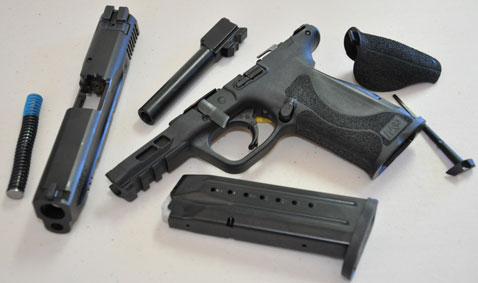 Field stripping the 2.0 is easy and doesn’t require pulling the trigger – a major safety improvement over “you know who” in my opinion. Unload the pistol, lock the slide to the rear, push down on the takedown lever located below the ejector using a ballpoint pen, punch or the insert pin, turn the takedown lever down and pull the slide forward off the frame. The captive recoil spring and barrel can then be lifted from the slide. Considering the frame is a polymer of some sort, the internal parts are mostly stainless steel and the stainless slide and barrel are coated with a meteor-proof super finish called Armornite the pistol isn’t likely to rust and should endure rough handling for decades.
Field stripping the 2.0 is easy and doesn’t require pulling the trigger – a major safety improvement over “you know who” in my opinion. Unload the pistol, lock the slide to the rear, push down on the takedown lever located below the ejector using a ballpoint pen, punch or the insert pin, turn the takedown lever down and pull the slide forward off the frame. The captive recoil spring and barrel can then be lifted from the slide. Considering the frame is a polymer of some sort, the internal parts are mostly stainless steel and the stainless slide and barrel are coated with a meteor-proof super finish called Armornite the pistol isn’t likely to rust and should endure rough handling for decades.
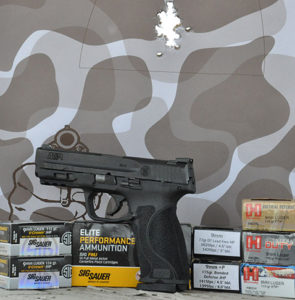 As you might expect the 2.0 ran flawlessly with a variety of practice and defensive ammunition from Hornady, Federal, Sig Elite, DoubleTap and a new company making remanufactured ammunition called AngelFire. This one’s a keeper and I’m thinking it will find a place as a training pistol, bedroom or house pistol and one I can loan to students. If you’re looking for a reliable, user-friendly pistol you need look no further than the new Smith & Wesson M&P 2.0.
As you might expect the 2.0 ran flawlessly with a variety of practice and defensive ammunition from Hornady, Federal, Sig Elite, DoubleTap and a new company making remanufactured ammunition called AngelFire. This one’s a keeper and I’m thinking it will find a place as a training pistol, bedroom or house pistol and one I can loan to students. If you’re looking for a reliable, user-friendly pistol you need look no further than the new Smith & Wesson M&P 2.0.
For more information:
About the Author:
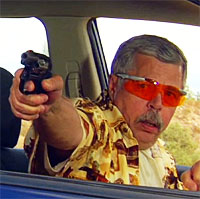 Ed Head is a regular on Shooting Gallery, Gun Stories and Down Range TV. He has worked for almost 30 years in law enforcement, first in the United States Air Force and then with the United States Border Patrol, retiring as a Field Operations Supervisor. During his Border Patrol career, Ed worked in a variety of patrol, investigative and training capacities. Ed has an extensive background as a firearms instructor, having trained thousands, ranging from beginners to police, military and special operations personnel. Having taught at Gunsite for 20 years, Ed first trained there under the world famous shooting school’s founder, Jeff Cooper, then later ran the school as the operations manager for more than five years. Ed lives in Chino Valley, Arizona, where he continues to teach and write.
Ed Head is a regular on Shooting Gallery, Gun Stories and Down Range TV. He has worked for almost 30 years in law enforcement, first in the United States Air Force and then with the United States Border Patrol, retiring as a Field Operations Supervisor. During his Border Patrol career, Ed worked in a variety of patrol, investigative and training capacities. Ed has an extensive background as a firearms instructor, having trained thousands, ranging from beginners to police, military and special operations personnel. Having taught at Gunsite for 20 years, Ed first trained there under the world famous shooting school’s founder, Jeff Cooper, then later ran the school as the operations manager for more than five years. Ed lives in Chino Valley, Arizona, where he continues to teach and write.

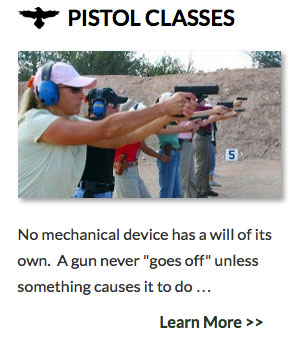

 MidwayUSA
MidwayUSA Ruger Firearms
Ruger Firearms SCCY Firearms
SCCY Firearms Streamlight
Streamlight Action Targets
Action Targets Gunsite Academy
Gunsite Academy
You must be logged in to post a comment Login